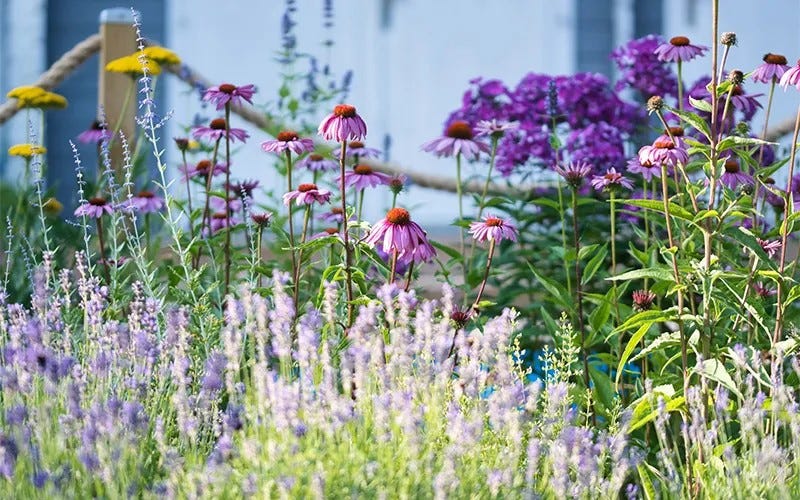
Frost Date Chart: First & Last Frost Dates Across North America
Frost dates are important for gardeners to know, as they signal the start and end of the gardening season. These charts can help you estimate when to expect the first frost in fall, and the last frost in spring, so that you know when to plant in your garden or meadow.
- First Fall Frost Date - when to expect the end of the gardening season in Fall
- Last Spring Frost Date - when to expect the start of the gardening season in Spring
Jump to a section to dig in:
Average Frost Dates For USDA Zones
Average frost dates by zone include data for a wide range of climates and locations. These dates can vary year by year. You'll also want to keep an eye on the season's weather trends for your area.
Not sure what zone you're in? See our guide: USDA Hardiness Zones & Finding Your Zone
| Zone | Average First Frost Date | Average Last Frost Date |
| 1 | August 25-31 | May 22-June 4 |
| 2 | September 1-8 | May 15-22 |
| 3 | September 8-15 | May 1-16 |
| 4 | September 21-October 7 | April 24-May 12 |
| 5 | October 13-21 | April 7-30 |
| 6 | October 17-31 | April 1-21 |
| 7 | October 29-November 15 | March 22-April 3 |
| 8 | November 7-28 | March 13-28 |
| 9 | November 25-December 13 | February 6-28 |
| 10 | December 15 - December 31 | January 1 - January 15 |
| 11+ | No usual frost | No usual frost |
Average Frost Dates For Major Cities
The chart below includes average frost dates for cities across the U.S. Find the cities near you for a good estimate of your frost dates. These dates can vary year by year, usually within about a two-week window.
| City, State | First Fall Frost Date | Last Spring Frost Date |
|---|---|---|
| Atlanta, GA | November 18 | March 17 |
| Baltimore, MD | November 17 | March 20 |
| Bismarck, ND | September 24 | May 12 |
| Boise, ID | October 17 | April 20 |
| Boston, MA | November 8 | April 6 |
| Buffalo, NY | October 25 | May 5 |
| Burlington, VT | October 8 | May 4 |
| Caribou, ME | September 21 | May 12 |
| Charleston, SC | December 10 | February 6 |
| Charleston, WV | October 5 | April 16 |
| Cheyenne, WY | September 27 | May 13 |
| Chicago, IL | October 28 | April 12 |
| Cincinnati, OH | October 25 | April 17 |
| Cleveland, OH | October 20 | April 8 |
| Columbia, SC | November 20 | March 15 |
| Dallax, TX | November 30 | March 4 |
| Denver, CO | October 14 | April 30 |
| Detroit, MI | October 20 | April 18 |
| Houston, TX | December 11 | February 3 |
| Indianapolis, IN | October 27 | April 19 |
| Jacksonville, FL | December 16 | February 6 |
| Kansas City, MO | November 2 | April 4 |
| Las Vegas, NV | December 4 | February 6 |
| Miami, FL | no frost | no frost |
| Milwaukee, WI | October 25 | April 22 |
| Minneapolis, MN | October 13 | April 23 |
| Mobile, AL | December 12 | February 26 |
| Nashville, TN | November 7 | April 6 |
| Newark, NJ | November 8 | April 3 |
| New Orleans, LA | December 23 | February 4 |
| New York, NY | November 12 | April 1 |
| Oklahoma City, OK | November 7 | March 27 |
| Philadelphia, PA | November 17 | March 31 |
| Phoenix, AZ | December 11 | January 6 |
| Pittsfield, MA | October 4 | May 7 |
| Portland, OR | December 1 | February 26 |
| Providence, RI | October 27 | April 13 |
| Raleigh, NC | November 16 | April 1 |
| Richmond, VA | November 8 | April 4 |
| Sacramento, CA | December 10 | February 9 |
| Salt Lake City, UT | November 6 | April 10 |
| Seattle, WA | December 1 | April 6 |
| St. Louis, MO | November 8 | April 9 |
| Washington, DC | November 17 | March 28 |
Frost Date Tips
- For more detailed frost dates for your location, try looking up your zip code using the tool at Dave's Garden.
- Soil temperature is a helpful piece of information in gardening, too. Wildflower seeds typically germinate when the soil is above 55°F, and many plants will wait for soil temperatures to rise to wake up from winter dormancy. Soil temperature is different than air temperature. Look up your soil temperature with GreenCast.
- When planting Wildflower seeds in the fall, plant after a killing freeze. That way, seeds can follow their natural course of germinating and sprouting the following spring.
- In the spring and fall, American Meadows will ship your order of perennial plants and flower bulbs at the right time to plant, based on your USDA zone!
Understanding Your Growing Season: Light Frost vs. Killing Frost, Hard Frost, or Freeze
When late fall arrives, you may start to see frost on the ground when you look out the window in the morning. Depending on how cold it is, you may see some frost before you see a freeze. What's the difference?
- A frost (ice crystals forming on surfaces) generally happens when the air temperature is between 36-32°F.
- A freeze happens when air temperature dips below 32°F. The colder it gets, the more damage you'll see to annual and perennial plants. A hard freeze is usually between 28-25°F, and a killing freeze is 24 degrees F and below.
How To Prepare For Frost
- With a killing frost, tender annuals are killed down.
- With a killing frost, perennials will show damage on their leaves, buds, and blooms.
- Some fall wildflowers are exceptions, with special traits that keep them blooming so they can fulfill their botanical objective of ripening their flowers into seeds. Many sunflowers and asters are in this group, often blooming right through the first frosts.
Learn more about plant lifecycles: The Difference Between Annuals, Perennials, & Biennials
Does Frost Make The Leaves Turn?
No. The changing color of leaves during fall is a completely separate phenomenon from the falling temperatures. Leaf color change is caused by the shortening of days from summer to fall. Interestingly, the brilliant fall color is there all summer, but until fall, it is hidden by the production of (green) chlorophyll. As days shorten in fall, leaves shut down their chlorophyll production, and their real pigments are revealed.


